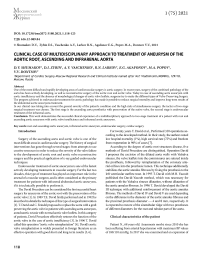Clinical case of multidisciplinary approach to treatment of aneurysm of the aortic root, ascending and infrarenal aorta
Автор: Shumakov D.V., Zybin D.I., Vaschenko A.V., Larkov R.N., Agafonov E.G., Popov M.A., Dontsov V.V.
Журнал: Московский хирургический журнал @mossj
Рубрика: Клинические случаи
Статья в выпуске: 1 (75), 2021 года.
Бесплатный доступ
One of the most difficult and rapidly developing areas of cardiovascular surgery is aortic surgery. In recent years, surgery of the combined pathology of the aorta has been actively developing, as well as reconstructive surgery of the aortic root and aortic valve. Today in case of ascending aorta aneurysm with aortic insufficiency and the absence of morphological changes of aortic valve leaflets, surgeons try to make the different types of Valve-Preserving Surgery. The progress achieved in endovascular treatments for aortic pathology has made it possible to reduce surgical mortality and improve long-term results of the abdominal aortic aneurysms treatment.In our clinical case taking into account the general severity of the patient's condition and the high risks of simultaneous surgery, the tactics of two-stage surgical treatment was chosen. The first stage is the ascending aorta prosthetics with preservation of the native valve, the second stage is endovascular treatment of the infrarenal aorta.Conclusion. This work demonstrates the successful clinical experience of a multidisciplinary approach to two-stage treatment of a patient with root and ascending aortic aneurysm with aortic valve insufficiency and infrarenal aortic aneurysm.
Root and ascending aortic aneurysm, infrarenal aortic aneurysm, endovascular surgery, cardiac surgery
Короткий адрес: https://sciup.org/142229623
IDR: 142229623 | УДК: 616.12-089.84 | DOI: 10.17238/issn2072-3180.2021.1.118-123
Текст научной статьи Clinical case of multidisciplinary approach to treatment of aneurysm of the aortic root, ascending and infrarenal aorta
Surgery of the ascending aorta and aortic valve is one of the most difficult areas in cardiovascular surgery. The history of surgical interventions has gone through several stages: from attempts to use creative resources in order to reduce the severity of the valve failure to the development of aortic root and aortic valve reconstructive surgery and the practical application of x-ray guided endovascular techniques.
Endovascular treatment of aortic aneurysms is one of the fastest actively-developing treatments in vascular surgery. For the last two decades, this type of treatment has played an important role in the arsenal of a vascular surgeon, and is often considered as the primary treatment for patients with infrarenal abdominal aortic aneurysm, if it is technically possible to perform it.
The David Procedure can be considered the first successful heart surgery for aneurysm of the aortic root with the preservation of the aortic valve [1]. In 1989 T.E. David firstly performed and in 1992 he described in details the technique of this type of surgical intervention [2]. T. David and C. Feindel proposed to replace the aorta with a graft preserving the aortic valve in patients with ascending aorta aneurysm, annuloaortic ectasia with normal aortic valve leaflets. In this category of patients, David Procedure effectively restores the function of the aortic valve in the case of aortic insufficiency [3]. In 1996 T. David called this operation “aortic valve reimplantation” [4]. David’s aortic valve reimplantation is widely presented in foreign literature as an effective operation with good short and long-term results [5, 6].
For twenty years T. David et al., Performed 330 operations according to the developed method. In their study, the authors noted low hospital mortality (1%), high survival rate (72%) and freedom from reoperation in 96% of cases [7].
According to the degree of aortic root structures disease, five methods of David Procedure are distinguished. Operation David I proposes the excision of the dilated aorta walls with Valsalva sinuses, the valve leaflets into the commissures are sutured inside the prosthesis, followed by reimplantation of the coronary arterial orifices into the prosthesic lumen. This technique additionally stabilizes the aortic annulus fibrosus by fixing the prosthesis to the left ventricular outflow tract. In 1995 T. David with M.H. Yacoub published the David-Yacoub method, which was necessary for patients with the Valsalva sinuses dilatation, without dilatation of the aortic annulus fibrosus. In 1996 T. David developed the David III technique with additional reinforcement of the aortic annulus fibrosus. The methods of David IV and David V are used depending on the difference in the diameter of the aortic annulus fibrosus and the proximal prosthesis diameter — 4 and 8 mm, respectively. It is expected to restore of the sinotubular ridge with two prostheses of different diameters for the root and tubular part of the aorta.
Clinical characteristics of the patient
Patient N., 68 years old. Anamnesis morbi: since 2010 she has been suffering from arterial hypertension with maximum BP values of 180/110 mmHg. In 2017 she was examined and an expansion of the ascending aorta up to 4.0 cm was revealed. In 2019 she noted a deterioration in condition, shortness of breath with minimal physical exertion appeared, also dull pain in the epigastrium started. The patient was referred for a consultation in Moscow Regional Research and Clinical Institute (MONIKI).
During an outpatient examination and using the instrumental research methods, including multispiral computed tomography (MSCT) (fig. 1, 2), a preliminary diagnosis was established: aneurysm of the root and ascending aorta (fig. 1). Infrarenal aortic aneurysm (fig. 2).
When performing MSCT of the thoracic and abdominal aorta with contrast an aneurysm of the ascending part (5.1 cm) (fig. 1) and the infrarenal part (6.0 cm) (fig. 2) of the aorta without signs of dissection was revealed.
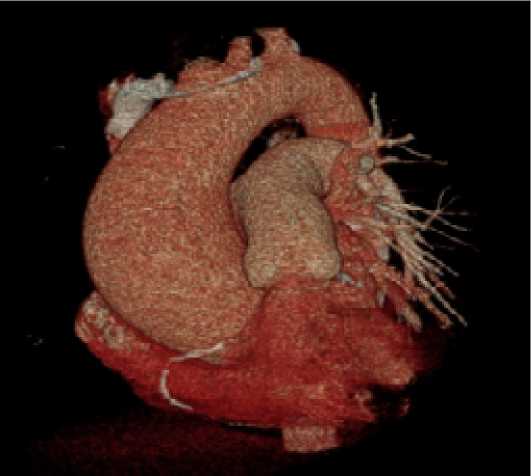
Fig. 1. Aneurysm of the ascending aorta
In March 2020 the patient with this diagnosis was admitted to the Moscow Regional Research and Clinical Institute (MONIKI), department of cardiac surgery for adults, for additional examinations and determination of further treatment tactics.
Chest X-rays - the aorta is dilated in the ascending part, rotated, compacted (fig. 3).
According to ultrasound of the abdominal aorta: US — signs of a primary aneurysm of infrarenal part of the abdominal aorta with parietal thrombosis.
During echocardiography aneurysmal dilatation of the aortic root (5.2 cm) and ascending aorta (4.9 cm) was found. Aortic insufficiency 2.5 st. Left atrial enlargement. The left ventricle is moderately enlarged. LV myocardial hypotrophy. EF 58%. EDV 151 ml.
A decision was made to perform a two-stage surgical treatment. The first stage was to perform prosthetics of the ascending aorta, the second stage — endovascular treatment of the infrarenal aorta.
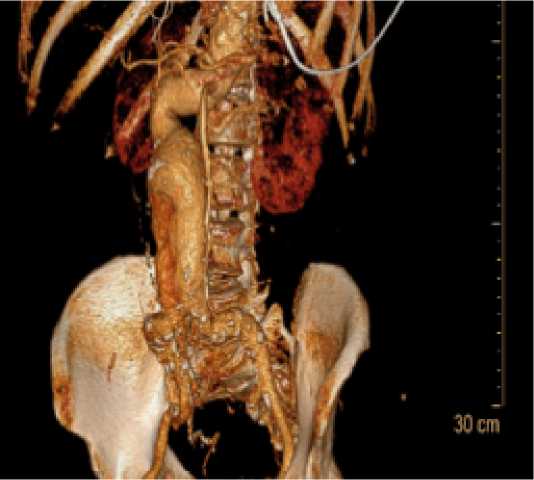
Fig. 2. Aneurysm of the infrarenal aorta
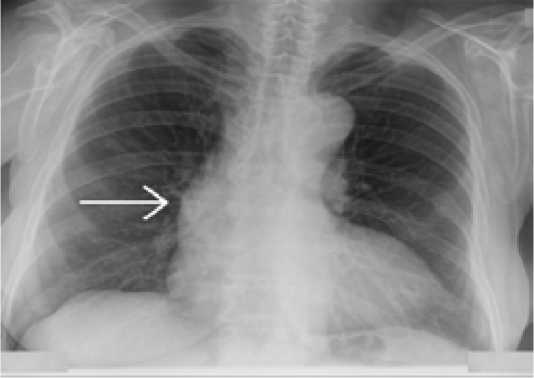
Fig. 3. Dilatation and rotation of ascending aorta
At the first ^age the patient underwent surgery — Pro^hetics of the ascending aorta with the «Intergrard-28» prosthesis with reimplantation of the aortic valve according to the David-I technique with separate reimplantation of the coronary artery orifices.
The surgery was performed according to the method accepted in the clinic. Intraoperatively enlargement of the aorta due to the Valsalva sinuses up to 5.5 cm and the ascending part up to 5.0 cm was revealed. Revision of the aortic valve (fig. 4) — the cusps are not changed, movable, the annulus fibrosus is dilated.
The cardiopulmonary bypass time was 202 minutes, the aortic occlusion time was 163 minutes. The early postoperative period was uneventful.
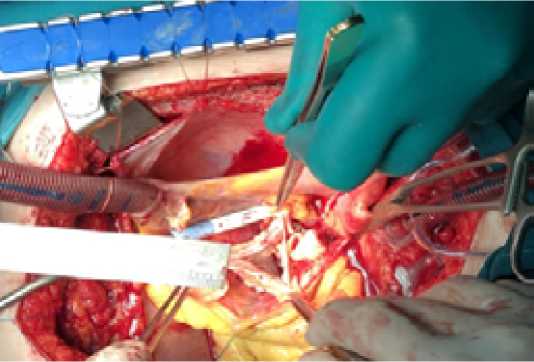
Fig. 4. Normal aortic valve leaflets
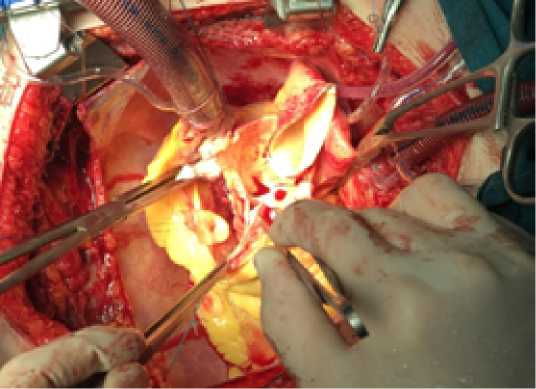
Fig. 5. Separated orifices of the coronary arteries
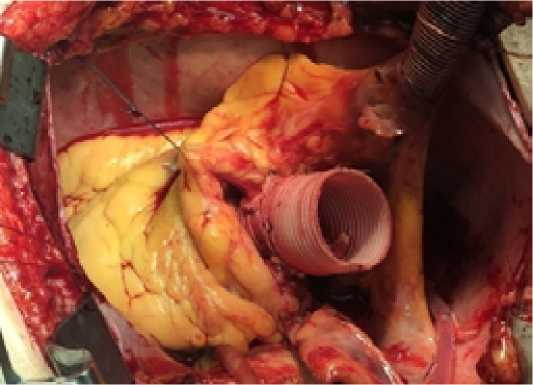
Fig. 7. Reimplantation of the orifices of the coronary arteries in vascular prosthesis
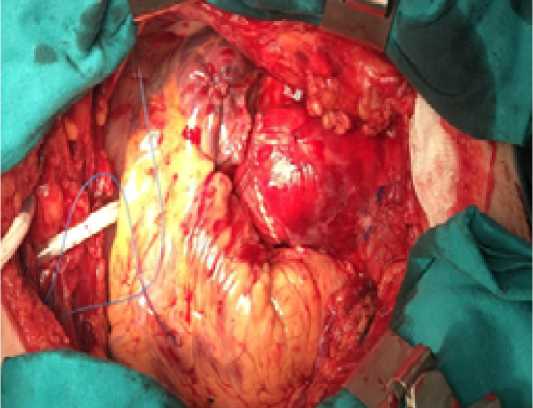
Fig. 8. Distal anastomosis of the prosthesis with the aorta, final view
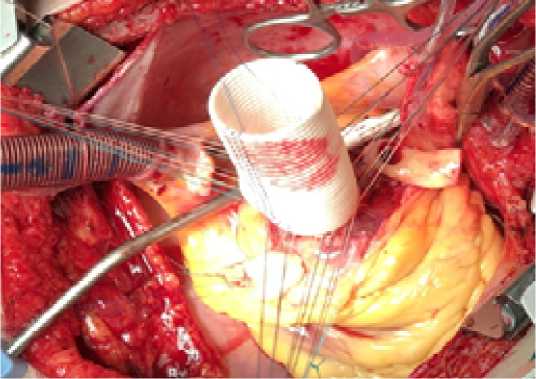
Fig. 6. Ascending aortic replacement with reimplantation of aortic valve using the David-I technique
The data of postoperative MSCT of the thoracic aorta are presented on a figure 9.
According to the results of echocardiography — proShetics of the ascending aorta is 2.8 cm, the function of the reimplanted aortic valve is not impaired, aortic insufficiency I. EF 68%. EDV 83 ml.
On the eighth day after the operation, the patient was discharged in a satisfactory condition.
6 months after the first stage of treatment the patient was admitted to MONIKI for the second stage of treatment. The patient underwent the planned operation: Implantation of a stent-graft (Endurant II) into the infrarenal aorta and iliac arteries. In the pictures: in the infrarenal part the aorta is dilated (fig. 10), significantly twisted, both common iliac arteries are dilated (fig. 11).
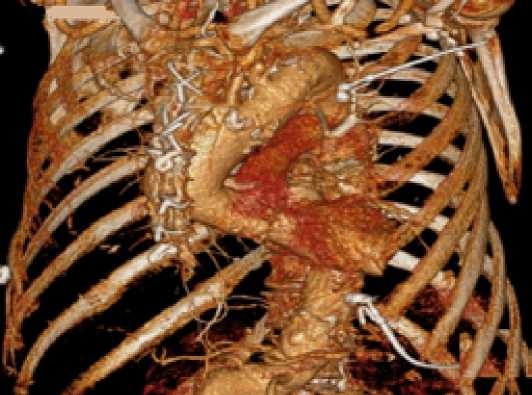
Fig. 9. Status post David-I surgery
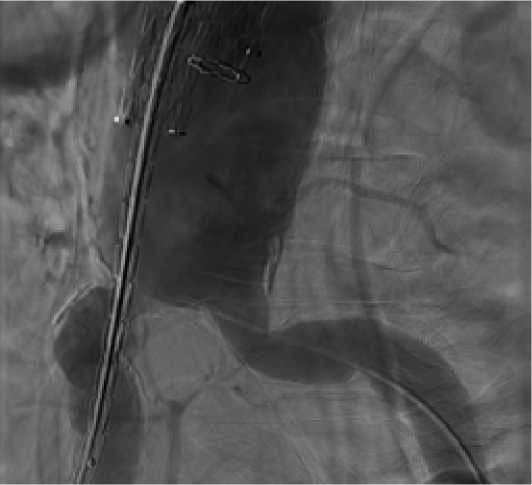
Fig. 11. Common iliac arteries
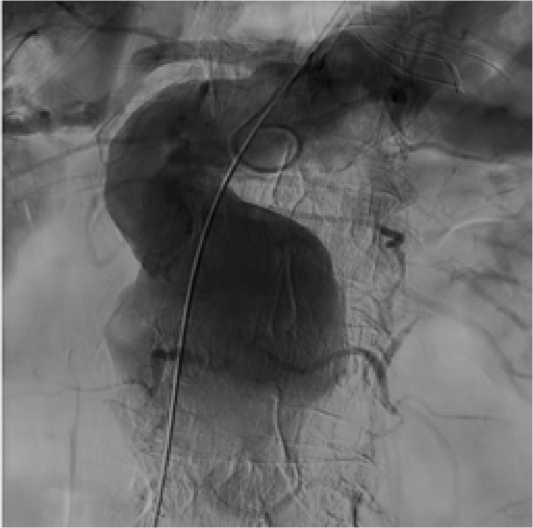
Fig. 10. Infrarenal part the aorta
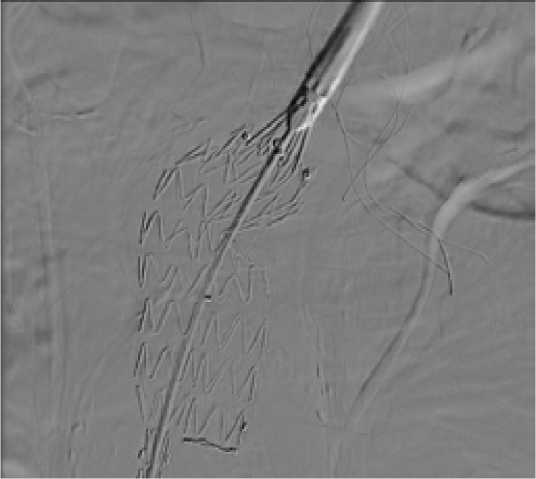
Fig. 12. The main part of stent-graft Endurant II
Due to the peculiarities of the abdominal aorta anatomy (pronounced tortuosity in the infrarenal region) in order to prevent the development of endolics in the postoperative period, endofixation of the proximal edge of the stent-graft body was performed with nine endofixers. On the control images the stent-graft is passable, there are no signs of contrasting outside the stent-graft (fig. 13, 14).
For the fourth day after the surgery the patient was discharged in satisfactory condition under the supervision of polyclinic physician at the place of residence.
INTERPRETATION
This work reflects the clinical experience of a multidisciplinary approach to two-stage treatment of a patient with the root and infrarenal aorta aneurysm. In our clinical case, taking into account the general severity of the patient’s condition and the high risk of simultaneous surgery, the tactics of two-stage surgical treatment was chosen. Considering the root and the ascending aorta aneurysm with normal aortic valve leaflets, the first stage of treatment was the replacement of the ascending aorta with the preservation of the native valve. This approach has some advantages: Firstly, this is a more physiological surgery, and secondly, it excludes the use of warfarin in the postoperative period and significantly reduces the risk of bleeding and others complications associated with taking warfarin in elderly patients, when performing the second stage of treatment. According to the literature data postoperative mortality in the planned resection of abdominal aortic aneurysms varies from 1 to 8% [8], while in endovascular prosthetics of the abdominal aorta it is less than 1% [9]. Consequently, the endovascular treatment of the infrarenal aorta was chosen as second stage of treatment.
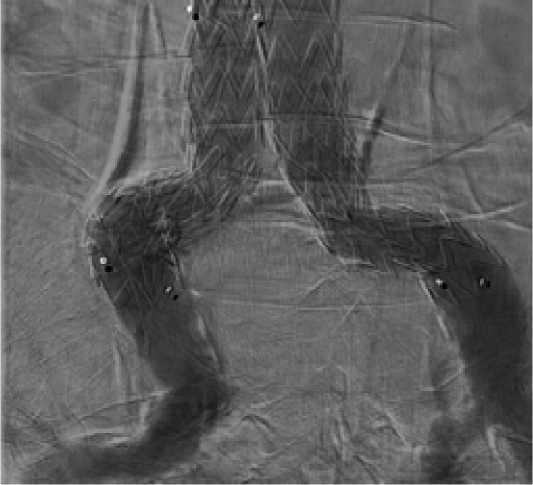
Fig. 13. Final view of implanted stent-graft (frontal view)
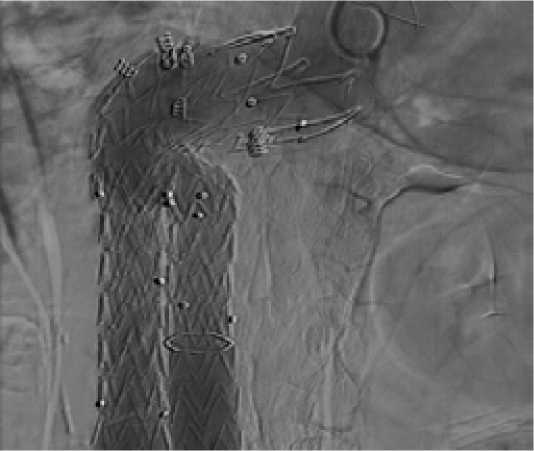
Fig. 14. Final view of implanted stent-graft (sagittal view)
CONCLUSION
The urgency of the problem of treating aneurysms of the ascending and abdominal aorta is connected with the large number of complications in this category of patients, that worsens the results of surgical treatment.
In this clinical case the importance of a multidisciplinary approach to two-stage treatment of patients with root and ascending aortic aneurysms, aortic valve insufficiency and infrarenal aortic aneurysms is shown and reflects the great importance of a personalized approach to the treatment of such patients in a multidisciplinary hospital .
Список литературы Clinical case of multidisciplinary approach to treatment of aneurysm of the aortic root, ascending and infrarenal aorta
- Komarov R., Karavaykin P., Murylev V. History of reconstructive surgery of aorta and aortic valve. Circulation Pathology and Cardiac Surgery, 2017, No. 21 (3S), рр. 45-60. DOI: 10.21688/1681-3472-2017-3S-45-60
- David T., Ivanov J., Armstrong S., Feindel C., Webb G. Aortic valvesparing operations in patients with aneurysms of the aortic root or ascending aorta. Ann Thorac Surg., 2002, Nov; No. 74 (5), рр. 1758-1761 DOI: 10.1016/S0003-4975(02)04135-8
- Birks E.J., Webb C., Child A., Radley-Smith R., Yacoub M.H. Early and long-term results of a valve-sparing operation for Marfan syndrome. Circulatio, 1999, No. 100 (19 Suppl.), рр. II29-II35. DOI: 10.1161/01.cir.100.suppl_2.ii-29
- David T.E. Remodeling the aortic root and preservation of the native aortic valve. Oper. Tech. Card. Thorac. Surg., 1996, No. 1 (1), рр. 44-56. DOI: 10.1016/S1085-5637(07)70080-3
- David T.E., Armstrong S., Maganti M., Colman J., Bradley T.J. Longterm results of aortic valve-sparing operations in patients with Marfan syndrome. J. Thorac. Cardiovasc. Surg., 2009, No. 138 (4), рр. 859-864. DOI: 10.1016/j.jtcvs.2009.06.014
- De Oliveira N.C., David T.E., Ivanov J., Armstrong S., Eriksson M.J., Rakowski H., Webb G. Results of surgery for aortic root aneurysm in patients with Marfan syndrome. J. Thorac. Cardiovasc. Surg., 2003, No. 125 (4), рр. 789-796. DOI: 10.1016/S1010-7940(00)00379-1
- David T.E., David C.M., Feindel C.M., Manlhiot C. Reimplantation of the aortic valve at 20 years. J. Thorac. Cardiovasc. Surg., 2017, No. 153, рр. 232-238. DOI: 10.1016/j.jtcvs.2016.10.081
- Hirsch A.T., Haskal Z.J., Hertzer N.R. et al. ACC/AHA 2005 practice guidelines for the management of patients with peripheral arterial disease (lower extremity, renal, mesenteric, and abdominal aortic): a collaborative report from the American Association for Vascular Surgery. Circulation, 2006, No. 113, рр. 463-654. DOI: 10.1161/Circulationaha.106.174526
- Perreas K., Samanidis G., Michalis A. et al.Outcomes after ascending aorta and proximal aortic arch repair using deep hypothermic circulatory arrest with retrograde cerebral perfusion: analysis of 207 patients. Interact Cardiovasc Thorac Surg., 2012, № 15, рр. 456 - 461. DOI: 10.1093/icvts/ivs252

